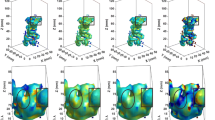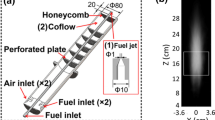Abstract
Turbulence motions are, by nature, three-dimensional while planar imaging techniques, widely used in turbulent combustion, give only access to two-dimensional information. For example, to extract flame surface densities, a key ingredient of some turbulent combustion models, from planar images implicitly assumes an instantaneously two-dimensional flow, neglecting the unresolved flame front wrinkling. The objective here is to estimate flame surface densities from two-dimensional measurements assuming that (1) the flow is statistically two dimensional; (2) the measuring plane is a plane of symmetry of the mean flow, either by translation (homogeneous third direction as in slot burners for example) or by rotation (axi-symmetrical flows such as jets) and (3) flame movements in transverse directions are similar. The unknown flame front wrinkling is then modelled from known quantities. An excellent agreement is achieved against direct numerical simulation (DNS) data where all three-dimensional quantities are known, but validations in other conditions (larger DNS, experiments) are required.










Similar content being viewed by others
References
Boger M, Veynante D, Boughanem H, Trouvé A (1998) Direct numerical simulation analysis of flame surface density concept for large eddy simulation of turbulent premixed combustion. In: Twenty-seventh symposium (international) on combustion. The Combustion Institute, pp 917–925
Bohm B, Kittler C, Nauert A, Dreizler A (2007) Diagnostics at high repetition rates: new ubsughts into transient combustion phenomena. In: 3rd European combustion meeting
Bray K, Champion M, Libby P (1989) The interaction between turbulence and chemistry in premixed turbulent flames. In: Borghi R, Murphy S (eds) Turbulent reacting flows, Lecture notes in engineering, vol. 40. Springer, New York, pp 541–563
Candel S, Poinsot T (1990) Flame stretch and the balance equation for the flame area. Combust Sci Technol 70:1–15
Cant R, Pope S, Bray K (1990) Modelling of flamelet surface to volume ratio in turbulent premixed combustion. In: 23rd symposium (international) on combustion. The Combustion Institute, Pittsburgh, pp 809–815
Dahm W, Buch K (1989) Lognormality of the scalar dissipation pdf in turbulent flows. Phys Fluids A 1(7):1290–1293
Domingo P, Vervisch L, Veynante D (2008) Large-eddy simulation of a lifted methane jet flame in a vitaited coflow. Combust Flame 152:415–432
Ducros F, Laporte F, Soulères T, Guinot V, Moinat P, Caruelle B (2000) High-order fluxes for conservative skew-symmetric-like schemes in structured meshes: application to compressible flows. J Comput Phys 161:114–139
Gottlieb S, Shu C (1998) Total variation diminishing runge-kutta schemes. Math Comput 67:73–85
Halter F, Chauveau C, Gokalp I, Veynante D (2009) Analysis of flame surface density measurements in turbulent premixed combustion. Combust Flame 156(3):657–664
Hawkes E, Cant S (2000) A flame surface density approach to large eddy simulation of premixed turbulent combustion. Proc Combust Inst 28:51–58
Hawkes E, Sankaran R, Chen J, Kaiser S, Franck J (2009) Analysis of lower-dimensional approximations to the scalar dissipation rate using direct numerical simulations of plane jet flames. Proc Combust Inst 32:1455–1463
Klein M, Sadiki A, Janicka J (2003) A digital filter based generation of inflow data for spatially developing direct numerical or large eddy simulation. J. Comput Phys 186(2):652–665
Knikker R, Veynante D, Meneveau C (2002) A priori testing of a similarity model for large eddy simulations of turbulent premixed combustion. Proc Combust Inst 29:2105–2111
Lachaux T, Halter F, Chauveau C, Gokalp I, Shepherd I (2005) Flame front analysis of high-pressure turbulent lean premixed methane–air flames. Proc Combust Institute 30:819–826
Lodato G, Domingo P, Vervisch L (2008a) Three-dimensional boundary conditions for direct and large-eddy simulation of compressible flows. J Comput Phys 227(10):5105–5143
Lodato G, Domingo P, Vervisch L, Veynante D (2008b) Scalar variances: Les against measurements and mesh optimisation criterion. scalar gradient: a three-dimensional estimation from planar measurements using DNS. In: Proceedings of the Summer Program, Center for Turbulence Research, NASA Ames/Stanford Univ
Nygren J, Hult J, Richter M, Alden M, Christensen M, Hultqvist A, Johansson B (2002) Three-dimensional laser induced fluorescence of fuel distributions in an hcci engine. Proc Combust Inst 29:679-685
Peters N (2000) Turbulent combustion. Cambridge University Press, Cambridge
Pitsch H (2006) Large-eddy simulation of turbulent combustion. Annu Rev Fluid Mach 38:453–482
Poinsot T, Veynante D (2005) Theoretical and numerical combustion, 2nd edn. Edwards Inc, Philadelphia
Pope S (1988) The evolution of surfaces in turbulence. Int J Eng Sci 26(5):445–469
Tao B, Katz J, Meneveau C (2002) Statistical geometry of subgrid-scale stresses determined from holographic particle image velocimetry measurements. J Fluid Mech 457:35–78
Tropea C, Yarin A, Foss J (2007) Springer handbook of experimental fluid mechanics. Springer, New York
Upton T, Verhoeven D, Hudgins D (2009) High resolution computed tomography of a turbulent reacting flow. Experiments in Fluids to be submitted
van der Bos F, Tao B, Meneveau C, Katz J (2002) Effects of small-scale turbulent motions on the filtered velocity gradient tensor as deduced from holographic particle image velocimetry measurements. Phys Fluids 14(7):2456–2474
Veynante D, Knikker R (2006) Comparison between les results and experimental data in reacting flows. J Turbul 7(35):1–20
Veynante D, Vervisch L (2002) Turbulent combustion modeling. Proc Energy Comb Sci 28(3):193–301
Veynante D, Piana J, Duclos J, Martel C (1996) Experimental analysis of flame surface density model for premixed turbulent combustion. In: Twenty-sixth symposium (international) on combustion. The Combustion Institute, pp 413–420
Acknowledgments
The authors warmly acknowledge the support of the Center for Turbulence Research (CTR) at Stanford University (USA). Most of this work has been performed during the 2008 Summer Programme organised by this institution (Lodato et al. 2008b). The direct numerical simulation analysed here was made possible by the computational resources provided by the national CNRS computing centre (IDRIS) and the CRIHAN.
Author information
Authors and Affiliations
Corresponding author
Appendices
Appendix A: isotropic distribution of the unit vector normal to the flame front
The objective of this appendix is to investigate some consequences of the assumption of an isotropic distribution of the unit vector normal to the flame front (i.e. all directions are equally probable). According to our notations (Sect. 3.1; Fig. 2), this normal vector is determined from the two angles θ and ϕ such as −π ≤ θ ≤ +π and −π/2 ≤ ϕ ≤ +π/2. The surface S of the sphere of radius unity defined by the extremity of the vector n is given by:
while the probability density functions p(θ) and p(ϕ), defining the distribution of both angles verifies:
Assuming an isotropic distribution of the vector n means that the probability that this vector points on an elementary surface \(\cos\phi d\phi d\theta\) is \(p(\theta)p(\phi) d\phi d\theta = \cos\phi d\phi d\theta / S.\) Then:
The mean value of \(\cos{\phi}\) becomes:
According to Eq. 11, the flame surface density Σ is directly related to its two-dimensional estimate Σ(x,y) as:
showing that the flame surface Σ is about 30% higher than its two-dimensional estimate.
The mean value of cos2ϕ is given by:
Replacing \(\langle \cos^2\phi \rangle_s\) by \(\langle \cos\phi \rangle_s^2\) in this situation introduces an error of about 7.5% on \(\langle \cos^2\phi \rangle_s.\) An isotropic distribution of the unit vector normal to the flame front corresponds to:
Then, Eq. 27 gives:
underestimating Eq. 18 with an error lower than 4%, expected to be below experimental uncertainties. The proposed model (Eq. 27) recovers satisfactorily well the isotropic case.
Appendix B: small ϕ angles
For small ϕ angles, Taylor series expansions of cosϕ and cos2ϕ give:
leading to, when surface averaged:
Accordingly, the assumption \({\langle \cos^2\phi \rangle}_s \approx {\langle \cos\phi \rangle}^2_s\) holds at the fourth order.
Appendix C: usual spherical coordinates
As pointed out in Sect. 3.1, the components of the unit vector n normal to the flame surface are expressed from angles θ and ϕ which are not the usual spherical coordinates (see Fig. 2). This choice is motivated for convenience: ϕ is the off-measuring plane angle and its mean value is expected to be zero for two-dimensional mean flows, while the mean value of θ is also expected to be zero, because of the cylindrical mean shape of the flame investigated here, making easier comparisons of angle distributions as displayed in Fig. 3. Of course, all the derivation in Sect. 3 may be recast in terms of usual spherical coordinates (τ, ψ) as defined in Fig. 11. Comparing Figs. 2 and 11 shows that angles (θ, ϕ) and (τ, ψ) are related through:
where k is an integer chosen to ensure a correct range of variations of τ, defined here as 0 ≤ τ ≤ 2π. Note that the angle θ is defined as positive when lying in the half-space x ≥0. For instantaneous two-dimensional flame fronts in the (x, y) plane, ϕ = 0 and ψ = π/2.
According to these notations, the components of vectors \({\bf n}_{(x,y)}\) and n are given by:
while \({\bf n}_{(x,y)}\) and \({\bf n}^p_{(x,y)}\) are related through:
Two- and three-dimensional gradients of the progress variable c are linked by:
where \(\sin\psi{\ge}0.\) Then:
Rights and permissions
About this article
Cite this article
Veynante, D., Lodato, G., Domingo, P. et al. Estimation of three-dimensional flame surface densities from planar images in turbulent premixed combustion. Exp Fluids 49, 267–278 (2010). https://doi.org/10.1007/s00348-010-0851-y
Received:
Revised:
Accepted:
Published:
Issue Date:
DOI: https://doi.org/10.1007/s00348-010-0851-y





